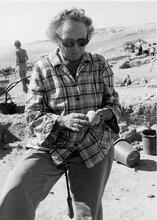Judith Marquet-Krause
Archaeologist Judith Marquet-Krause, ca. 1933. Source: Wikimedia Commons
Born and raised in Palestine, Judith Marquet-Krause left her home for Paris to study French in hopes of becoming a French teacher. After changing her mind several times, Marquet-Krause finally decided to study archaeology, specifically that of Erez Israel. She returned to Palestine in the early 1930s, where she was accepted to the team of archaeologist John Garstand, who excavated Jericho. Her most notable accomplishment came in 1933 when she was appointed to lead the excavation at the ancient city of Ai and determine whether the Book of Joshua’s description of the city—as a royal Canaanite city conquered by the Israelites during the conquests of Joshua—was accurate. An early death cut short her promising career as an archeologist of Biblical cities.
Early Life and Education
Judith Marquet-Krause was born in Sejera (Ilaniyyah) in the Lower Galilee and died of illness in 1936. She was married to the Orientalist Yves Marquet.
Marquet-Krause’s father, Eliyahu Krause (1876–1962), an agronomist, was employed by Baron Edmond de Rothschild and appointed manager of the training farm in Sejera in 1901. In 1914 he was appointed director of the Mikveh Israel agricultural school, where his family moved together with him.
After completing her schooling at the Herzlia Hebrew Gymnasia, Marquet-Krause studied French in Paris in order to become a French teacher. However, in the course of her studies she changed direction and began studying medieval history and literature at the Sorbonne. At the same time she learned Akkadian, Syrian and Armenian at the École des hautes études and decided to study the archaeology of The Land of IsraelErez Israel and the Near East at the Louvre du École. During her studies she visited the major museums in Europe and the Middle East and also traveled to archaeological excavations in Erez Israel and Syria.
Archeological Career
On returning to Palestine in 1932 or 1933 she was accepted to the archaeological team of John Garstang (1876–1956), who excavated Jericho. There Marquet-Krause was appointed to deal with artifacts discovered in graves.
At the age of 27 she reached the pinnacle of her career when Baron de Rothschild appointed her to direct the archaeological team excavating the city of Ai. This ancient city was identified by William F. Albright (1891–1971) at et-Tel near the village of Dir Dibwan, approximately two kilometers southwest of Beth-El in the Judea and Samaria region. Marquet-Krause’s goal was to confirm the Book of Joshua’s description of the city of Ai as a royal Canaanite city which, together with Beth-El, was conquered by the Israelites during the conquests of Joshua and after the conquest of Jericho.
Marquet-Krause excavated Ai for three seasons between 1933 and 1935. She managed to prepare two preliminary reports while her husband provided a report of the ceramic findings, floor plans and photographs.
Impact of Excavation
Evidence from Marquet-Krause’s excavation indicated that Ai was a fortified city of the highest significance during the Early Bronze Age, between 3100 and 2400 B.C.E., when it was completely destroyed and abandoned. Among the findings were a temple in which vessels of clay and Egyptian alabaster were found, together with unique vessels and graves, which contained artifacts that greatly enriched the findings from that period.
Above the ruins of the prehistoric city Marquet-Krause’s team found remnants of an unfortified village from the early Israelite period. The first settlement of that period was built in 1220 B.C.E., evidently by local residents, and existed until 1050 B.C.E.. Although the village had been abandoned by its residents, the archaeological team found no evidence of destruction, fire or conquest.
Marquet-Krause was a pioneer among archaeologists who were born in Erez Israel and sought to learn the secrets of its past. She was the first archaeologist to manage so large an excavation team and to prepare the first reports in Hebrew.
Her early death cut short what would have been the career of an important archaeologist.
Selected Works
“The Ai Excavations.” News of the Hebrew Society for Research of Erez Israel and Its Ancient Artifacts 1, no. 4 (1934): 28–30.
“Les fouilles d’Ay, 1933–1935: Le resurrection d’une grande cité biblique” (The excavations of Ai, 1933-1935: The Resurrection of a Large Biblical City). Bibliothêque Archéologique et Historique 45 (1949).




